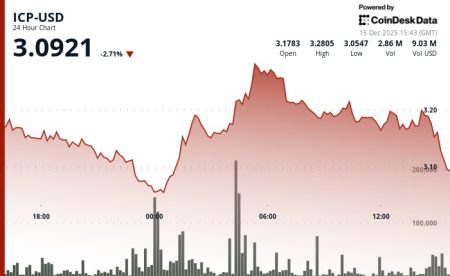Bitcoin Market Braces for Potential 80 Percent Correction, Warns Veteran Analyst Willy Woo
Global Liquidity Concerns Cast Shadow Over Cryptocurrency’s Bullish Expectations
As October begins—traditionally considered a bullish month for cryptocurrencies—Bitcoin investors find themselves at a crossroads of optimism and caution. While many market participants anticipate a rally in Bitcoin (BTC) and alternative cryptocurrencies, respected analyst Willy Woo has issued a sobering warning that contradicts this positive sentiment. According to Woo’s recent analysis, Bitcoin could potentially face an 80 percent correction despite its overall strength in 2025, raising significant questions about the sustainability of current price levels and market dynamics.
The cryptocurrency market has demonstrated remarkable resilience throughout much of 2025, with Bitcoin maintaining relatively strong positions and institutional adoption continuing to grow. However, according to Woo’s comprehensive assessment delivered through a recent YouTube video, concerning signs of market exhaustion are beginning to emerge that investors should not ignore. The veteran analyst points to diminishing global liquidity as the primary catalyst for a potential steep correction, drawing parallels to previous market cycles where similar conditions preceded major downturns. “Liquidity acts as the oxygen of the market. When it expands, prices rise easily. When it contracts, the entire risk curve collapses,” Woo explained, highlighting how the fundamental relationship between liquidity and asset prices transcends even the strongest market narratives.
Diminishing Global Liquidity Poses Critical Threat to Cryptocurrency Valuations
The core of Woo’s argument centers on the contraction of global liquidity—a factor that has historically proven decisive for cryptocurrency performance regardless of other positive developments. According to his analysis, current market conditions increasingly resemble previous late-cycle phases that ultimately led to significant price corrections across the cryptocurrency ecosystem. This assessment is particularly noteworthy given the Federal Reserve’s tapering of liquidity injections, which previously provided substantial cash flow into risk assets including cryptocurrencies. As Woo pointed out, “Liquidity injections from the Federal Reserve are also tapering off, diminishing the cash flow that once fueled the rally. Prices remain high, but the capital behind them is weakening.” This divergence between market valuations and underlying capital strength represents a critical vulnerability that could manifest in sharp price declines.
The cryptocurrency market’s dependence on broader financial liquidity places it in a precarious position despite its growing institutional legitimacy. In his analysis, Woo emphasized that Bitcoin typically experiences more severe reactions to liquidity contractions than traditional markets. “While traditional markets can fall by up to a third during recessions, Bitcoin and altcoins typically lose 70-80% of their value,” he noted. This historical pattern underscores the amplified volatility inherent to cryptocurrency markets during periods of economic stress—a characteristic that remains unchanged despite the sector’s maturation. The analyst’s projection of an 80 percent correction does not stem from concerns about Bitcoin’s fundamental value proposition or technological foundations, but rather from macro-economic forces that have consistently demonstrated their influence over cryptocurrency markets.
Market Structure Improvements May Mitigate but Not Prevent Potential Downturn
Despite the alarming correction prediction, Woo acknowledged significant structural improvements in the cryptocurrency ecosystem that distinguish the current market from previous cycles. Cryptocurrency exchanges now maintain more transparent reserves, regulatory frameworks have evolved substantially, and the introduction of spot Bitcoin ETFs has shifted liquidity toward regulated markets with reduced leverage. These developments represent meaningful progress in the market’s infrastructure and regulatory integration, potentially reducing some systemic risks that exacerbated previous downturns. However, Woo cautioned that these improvements, while significant, do not render the market immune to macroeconomic pressures—particularly those related to global liquidity conditions.
“In this context, Bitcoin, which is at the top, always gives the first and harshest reaction,” Woo explained, emphasizing that even the strongest market fundamentals are tested when liquidity conditions deteriorate. This perspective highlights a crucial distinction between cryptocurrency-specific factors and broader economic forces. While factors like technological adoption, institutional integration, and regulatory clarity have advanced substantially, Bitcoin and other cryptocurrencies remain inextricably linked to global capital flows. This connection means that when liquidity contracts across financial markets, cryptocurrencies—despite their increasingly robust ecosystem—remain vulnerable to significant valuation adjustments. The analyst’s warning serves as a reminder that structural improvements in the cryptocurrency market represent necessary but insufficient protection against macroeconomic headwinds.
Implications for Investors and Market Participants in the Coming Months
For cryptocurrency investors navigating this challenging landscape, Woo’s analysis presents important considerations for risk management and investment strategy. The potential for an 80 percent correction, while representing an extreme scenario, aligns with historical precedents in cryptocurrency market cycles. Investors should recognize that stronger market catalysts might slow such a decline but are unlikely to prevent it entirely if global liquidity continues to contract. “Stronger catalysts can slow the decline, but cannot defy it,” Woo noted, suggesting that even positive developments specific to the cryptocurrency sector would struggle to overcome the powerful influence of broader liquidity trends.
As October unfolds—a month traditionally associated with positive performance for Bitcoin—market participants face the challenge of reconciling historical seasonal patterns with current macroeconomic realities. Woo’s warning stands in stark contrast to the optimistic expectations that typically accompany this period of the year, highlighting the evolving nature of cryptocurrency market dynamics. While the analysis does not predict immediate price movements, it frames the current market within a broader context of risk and vulnerability that prudent investors cannot afford to ignore. As always, diversification, position sizing, and careful risk assessment remain essential practices for navigating the inherently volatile cryptocurrency landscape, particularly during periods of potential macroeconomic stress. While Bitcoin has demonstrated remarkable resilience throughout its history, Woo’s analysis serves as a timely reminder that market cycles—including significant corrections—remain an integral part of its evolutionary journey.













